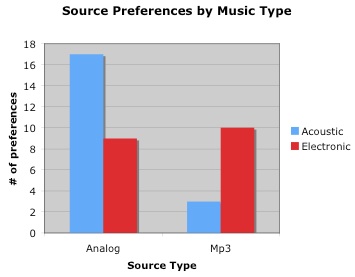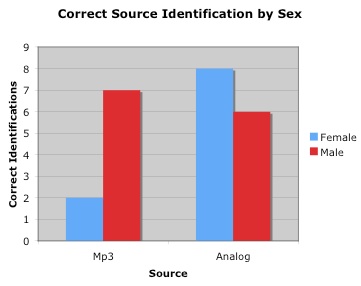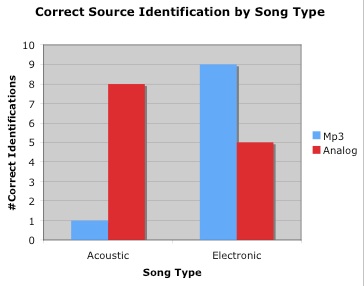Results:


Conclusions:
At the beginning of this investigation we sought to determine whether or not a person presented with two samples of music––one primarily acoustic and the other primarily electric, and each played in random order in vinyl and MP3 format––can accurately perceive differences in audio quality between music formats. Attempting to answer this question we tested ten male and ten female subjects, each of whom listened to samples of the Pixies’ “Where Is My Mind?” and New Order’s “Blue Monday.” Among the questions we considered during testing:
1) Might males and females demonstrate different preferences in audio format?
– Furthermore, would these differences be reflected when the genre of the music changes?
2) Might males and females differ in accuracy regarding which source is which?
– As with Question 1, might these differences be reflected when the genre of the music changes?
3) Might perceived higher quality in a particular genre of music be associated with either the LP (vinyl) or MP3 (computer) format?
Upon completion of our testing we disaggregated the data into the following categories and sub-categories:
# of people who determined the sound sources correctly for both songs: 7/20.
Of those:
Males: 4/7.
Females: 3/7.
# of people who determined the sound sources correctly for “What Is My Mind?”: 9/20.
Of those:
Males: 5/9.
Females: 4/9.
# of people who determined the sound sources correctly for “Blue Monday”: 14/20.
Of those:
Males: 8/14.
Females: 6/14.
# of people who preferred the LP for “Blue Monday”: 9/20.
Of those:
Males: 3/9.
Females: 6/9.
# of people who preferred the computer for “Blue Monday”: 10/20.
Of those:
Males: 7/10.
Females: 3/10 (One female was indecisive).
# of people who preferred the LP for “Where Is My Mind?”: 17/20
Of those:
Males: 8/17.
Females: 9/17.
# of people who preferred the computer for “Where Is My Mind?”: 3/20
Of those:
Males: 2/3.
Females: 1/3.
From this data we can arrive at the following conclusions:
In response to Question 1:
– Of those who preferred the LP with “Blue Monday,” the majority (6/9) were female. Of those who preferred the computer, the majority (7/10) were male.
– Of those who preferred the LP with “Where Is My Mind,” 9/17 were female. Of those who preferred the computer, 2/3 were male.
– For “Blue Monday,” we can see a clear pattern of males preferring a digital format, whereas females prefer an analog format. For “Where Is My Mind,” there is no decisive margin in either direction. This seems to suggest that, for electronic music, format differences trigger more divided reactions among males and females than with acoustic music.
In response to Questions 2 and 3:
– Of those who correctly determined which source was the computer with “Blue Monday,” only a slim majority were male (8/14). Of those who correctly determined which source was the computer with “Where Is My Mind,” the same was true (5/9). This data, given our small sample size, is inconclusive, but could simply be telling us that males and females are equally adept at perceiving differences in sound quality.
– Interestingly, 14 of the subjects were correct with “Blue Monday,” a 55.5% greater number than were correct for “Where Is My Mind?” The great difference in accuracy between the two songs is interesting when one considers that a very high 17/20 people preferred the LP for “Where Is My Mind?” while preferences were more split for “Blue Monday.” We believe this could reflect a bias among test subjects who believe higher quality in acoustic music such as “Where Is My Mind?” is linked to vinyl, while higher quality in electronic music such as “Blue Monday” is linked to MP3s. This potential bias is reflected in test subject comments about the particular qualities they noticed while listening. For example, “Blue Monday” as an MP3 was frequently cited for better and more distinct bass, while “Where Is My Mind?” as an LP was noted for clearer instrumentation.
– Ultimately it seems that, aside from a statistically significant difference in preferences of format for electronic music, there is little discernable difference in audio perception or preference between males and females. Most apparently, though, it seems that people generally have less than a random coin toss’ chance of guessing both sources in both audio samples correctly (7/20 managed to achieve this). People are more able to do so for electronic music than for acoustic music, but because of the way in which the potential bias toward a specific format for a specific genre may have colored people’s guesses, the electronic/acoustic distinction regarding accuracy is inconclusive. On the whole, however, it seems that the human ear picks up on relatively few differences in MP3s and LPs, formats of definitively varied quality.


